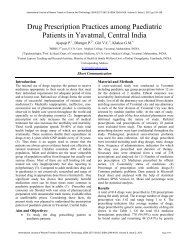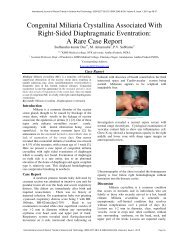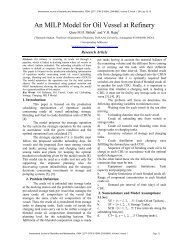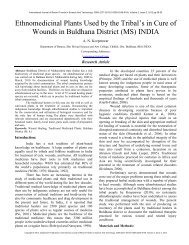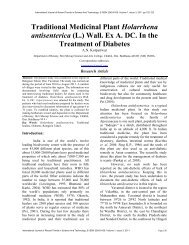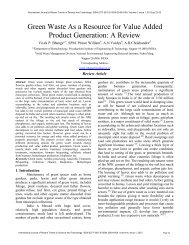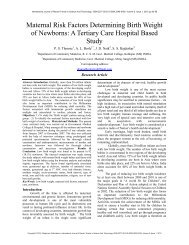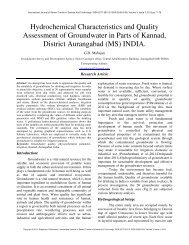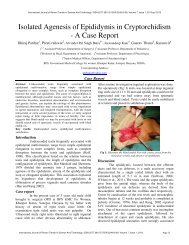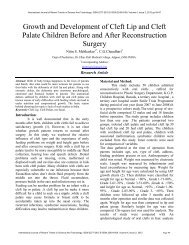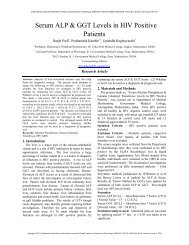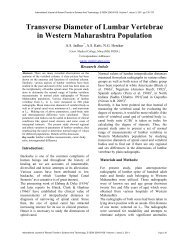Dimensions of Cervical Spinal Canal and Vertebrae ... - Statperson
Dimensions of Cervical Spinal Canal and Vertebrae ... - Statperson
Dimensions of Cervical Spinal Canal and Vertebrae ... - Statperson
You also want an ePaper? Increase the reach of your titles
YUMPU automatically turns print PDFs into web optimized ePapers that Google loves.
International Journal <strong>of</strong> Recent Trends in Science And Technology, ISSN 2277-2812 E-ISSN 2249-8109, Volume 3, Issue 2, 2012 pp 54-58<strong>Dimensions</strong> <strong>of</strong> <strong>Cervical</strong> <strong>Spinal</strong> <strong>Canal</strong> <strong>and</strong> <strong>Vertebrae</strong><strong>and</strong> Their Relevance in Clinical PracticeM. A. Kathole 1 , R. A. Joshi 2 , N. G. Herekar 3 , S.S. Jadhav 2{ 1 Assistant Pr<strong>of</strong>essor, 2 Associate Pr<strong>of</strong>essor, 3 Pr<strong>of</strong>essor <strong>and</strong> Head}Dept. <strong>of</strong> Anatomy, Govt. Medical College, Miraj (MS), INDIA.Corresponding Addresses:mahendra.kathole@rediffmail.comResearch ArticleAbstract: There exist a direct correlation between the dimension <strong>of</strong>the spinal canal <strong>and</strong> its associated consequences after trauma. Thedimensions <strong>of</strong> the canal can influence the possibility whether anindividual will suffer prolonged effect, after a spinal injury in thatarea. And it will also influence the recovery time. <strong>Dimensions</strong> <strong>of</strong>dry bones <strong>of</strong> vertebrae can easily be obtained. However, fromclinical point <strong>of</strong> view, obtaining the dimensions <strong>of</strong> vertebrae inlivings is more important. So, in the present study, normal lateralradiographs <strong>of</strong> cervical spine <strong>of</strong> three hundred Western Maharashtraadult subjects with known age <strong>and</strong> known sex were studied. Thirdto seventh cervical vertebrae were studied in the present study. Theparameters used in the study are viz. anteroposterior diameters <strong>of</strong>spinal canal <strong>and</strong> vertebral bodies. Making use <strong>of</strong> anteroposteriordiameters <strong>of</strong> spinal canal <strong>and</strong> vertebral bodies, canal body ratio(Torg’s ratio) was calculated. It was observed that theanteroposterior diameters <strong>of</strong> cervical spinal canal <strong>and</strong> vertebralbodies showed sexual dimorphism. Comparison <strong>of</strong> these vertebraldimensions with corresponding dimensions from other ethnicgroups showed evidence <strong>of</strong> racial variation. These parameters canbe used as reference values for evaluating various clinicalconditions like spinal stenosis <strong>and</strong> intraspinal tumours in thecervical spine in Western Maharashtra population.Key Words: spinal canal, vertebral bodies, canal body ratio, spinalstenosis, intraspinal tumoursIntroduction:The exact dimensions <strong>of</strong> cervical vertebral body <strong>and</strong>spinal canal are an important consideration in thediagnosis, prognosis <strong>and</strong> treatment <strong>of</strong> diseases related tocervical spine <strong>and</strong> spinal cord, such as spinal stenosis <strong>and</strong>intraspinal tumours, etc.Lindgren [1] was first, whopointed out the importance <strong>of</strong> anteroposterior (sagittal)diameter <strong>of</strong> the cervical spinal canal.The careful study <strong>of</strong> plane radiographs <strong>of</strong> cervicalspine can accurately estimate dimensions <strong>of</strong> vertebralbody <strong>and</strong> spinal canal. Furthermore, it is easily available<strong>and</strong> more economical from patient’s point <strong>of</strong> view.S o , for the present study plain radiographs were usedThere can be either narrowing or enlargement <strong>of</strong>spinal canal because <strong>of</strong> some pathological process. <strong>Spinal</strong>stenosis is understood to be a narrowing <strong>of</strong> the spinalcanal. . [2]. The narrowing can be either congenital oracquired. And conditions like intraspinal tumor leads toenlargement <strong>of</strong> spinal canal. Similarly, there can be eitherincrease or decrease in the dimensions <strong>of</strong> vertebral bodies.Hence it is important to know the normal dimensions <strong>of</strong>the vertebral bodies.Several studies describing the dimensions <strong>of</strong> cervicalspine have been done in Western countries. But,significant statistical differences have been found toexist between different population groups. Also, it isobserved that there is racial variation in thesedimensions. Similar studies describing the dimensions <strong>of</strong>cervical spine done in normal Indian subjects arerelatively few. So, present work was undertaken toestablish the normal dimensions <strong>of</strong> cervical vertebrae <strong>and</strong>spinal canal in the Western Maharashtra population.Material <strong>and</strong> Methods:For present study, normal lateral radiographs <strong>of</strong>cervical spine <strong>of</strong> three hundred adult subjects <strong>of</strong> knownsex (one hundred <strong>and</strong> fifty males <strong>and</strong> one hundred <strong>and</strong>fifty females) <strong>and</strong> <strong>of</strong> known age group (between twentyfive to forty years <strong>of</strong> age).from Western Maharashtrawere utilized.The radiographs <strong>of</strong> both sexes were taken withsubjects st<strong>and</strong>ing straight in neutral relaxed position,forward facing to a defined point to prevent rotation <strong>of</strong>the neck, with shoulders relaxed <strong>and</strong> arms down. Thedistance between X-ray tube <strong>and</strong> film plate was 1.5meter. The X-ray tube was focused on the fourth cervicalvertebra. These radiographs were diagnosed as “normalby experienced radiologists. The radiographs showingany obvious abnormality were excluded from the study.The measurements were made by using scalecalibrated to 0.5 mm. The dimensions <strong>of</strong> C3 to C7cervical vertebrae were studied.A) The antero-posterior diameter <strong>of</strong> cervical spinalcanal:This is the minimum distance between midpoint <strong>of</strong> theposterior border <strong>of</strong> vertebral body shadow <strong>and</strong> shadow <strong>of</strong>spinolaminal junction <strong>of</strong> same vertebra. [As shown inPLATE - 1]B) The antero-posterior diameter <strong>of</strong> vertebral body:This is midvertebral distance between the mid-points onanterior border <strong>and</strong> posterior border <strong>of</strong> vertebral bodyshadow. [As shown in PLATE - 1]Using above measurements the ‘canal body ratio’ wasobtained.The ‘canal body ratio’ (Torg’s ratio, Pavlov’s ratio)[3]: [As shown in PLATE - 1]International Journal <strong>of</strong> Recent Trends in Science And Technology, ISSN 2277-2812 E-ISSN 2249-8109, Volume 3, Issue 2, 2012 Page 54
M. A. Kathole, R. A. Joshi, N. G. Herekar, S.S. JadhavTable no. 2: Showing dimensions <strong>of</strong> anteroposterior diameters (in mms) <strong>of</strong> cervical vertebral bodies in both sexesLevel Sex group Range Mean S. D.Calculated range(Mean + 3 S.D.)C3M 14.0-22.0 17.76 +2.44 10.44 – 25.08F 12.0-19.5 14.98 +1.93 9.19 – 20.77C4M 13.5-21.0 17.28 +2.34 10.26 – 24.30F 11.5.-19.0 14.47 +2.02 8.41 – 20.53C5M 13.5-21.0 16.87 +2.25 10.12 – 23.62F 11.0-19.0 14.06 +1.97 8.15 – 19.97C6M 14.0-21.0 17.13 +2.27 10.52 – 23.94F 11.0-19.0 14.38 +1.98 8.44 – 20.32C7M 14.5-22.0 17.45 +2.29 10.53 – 24.32F 11.5-19.0 14.7 +1.99 8.03 – 20.67Table no. 3: Showing canal body ratio in both sexes.Level Sex group Mean S. D.Calculated range(Mean + 3 S.D.)C3M 0.95 +0.06 0.77 – 1.13F 1.06 +0.06 0.88 – 1.24C4M 0.95 +0.06 0.77 – 1.13F 1.07 +0.07 0.86 – 1.28C5M 0.95 +0.06 0.77 – 1.13F 1.08 +0.07 0.87 – 1.29C6M 0.96 +0.06 0.78 – 1.14F 1.08 +0.07 0.87 – 1.29C7M 0.96 +0.06 0.78 – 1.14F 1.07 +0.07 0.86 – 1.28Z - Value P - Value11.12 < 0.0111.24 < 0.0111.7 < 0.0111.27 < 0.0111.45 < 0.01Z- Value P- Value15.94 < 0.0115.89 < 0.0117.22 < 0.0115.89 < 0.0114.56 < 0.01Discussions:The Anteroposterior Diameter <strong>of</strong> <strong>Cervical</strong> <strong>Spinal</strong> <strong>Canal</strong>:The importance <strong>of</strong> measurement <strong>of</strong> the anteroposteriordiameter <strong>of</strong> cervical spinal canal is well established.The interpedicular distance (transverse diameter) <strong>of</strong>cervical spinal canal is nearly twice the anteroposteriordiameter <strong>of</strong> the spinal canal. Therefore, there is more roomfor the spinal cord to exp<strong>and</strong> sideways while less space toexp<strong>and</strong> in the anteroposterior direction. For this reason, theanteroposterior diameter <strong>of</strong> cervical spinal canal isconsidered the most useful measurement. Also, Hwan-MoLee et al. [5] have mentioned that the anteroposteriordiameter <strong>of</strong> cervical spinal canal is more useful thantransverse diameter in the diagnosis <strong>of</strong> cervical spinalstenosis.Lindgren. [1] believes that the measurement <strong>of</strong> theanteroposterior diameter <strong>of</strong> cervical spinal canal in plainlateral radiography is reliable, more so than the transversediameter.Enlargement <strong>of</strong> spinal canal is usually associated withabnormal flattening or even medial concavity <strong>of</strong> the vertebralsurfaces bordering the canal. Local expansion is generallyevident from comparison with adjacent levels. Adifference <strong>of</strong> 3 mm or more in the dimensions <strong>of</strong> cervicalspinal canal between adjacent vertebral levels is said to beabnormal (David Sutton) [6].Knowledge <strong>of</strong> normal measurement <strong>of</strong> the anteroposteriordiameter <strong>of</strong> cervical spinal canal helps in the diagnosis <strong>of</strong>various clinical conditions associated with cervical spine,such as stenosis, space occupying lesions, etc.From the table no. 4, it was observed that, for males,values <strong>of</strong> anteroposterior diameters <strong>of</strong> spinal canal werehighest in the work <strong>of</strong> Payne <strong>and</strong> Spillane [7] , <strong>and</strong> lowest inthe work <strong>of</strong> Hashimoto <strong>and</strong> Tak [8]. The values <strong>of</strong> presentstudy group fall in between the two. The differences noted inthe studies <strong>of</strong> Gupta et al. [9], D. N. Verma et al. [10] <strong>and</strong>present study, were probably because <strong>of</strong> difference in thestature <strong>of</strong> people <strong>of</strong> these groups. The values <strong>of</strong> meananteroposterior diameters <strong>of</strong> spinal canal in present studygroup were comparable with those <strong>of</strong> Higo et al [11]. Similarto males, there was variation in the anteroposterior diameter<strong>of</strong> spinal canal in females, among various studies done bydifferent authors, in various ethnic groups. This differencecould be due to racial variation. The findings <strong>of</strong>anteroposterior diameter <strong>of</strong> spinal canal <strong>of</strong> females in presentstudy correlate well with the study <strong>of</strong> D. N. Verma et al[10]..Table no. 4: Showing comparison <strong>of</strong> mean anteroposterior diameters (in mms) <strong>of</strong> spinal canal in both sexes between previous studies <strong>and</strong> present studySERIESMaleFemaleNo. C3 C4 C5 C6 C7 C3 C4 C5 C6 C7Payne <strong>and</strong> Spillane 1959 (British) - 18.6 17.5 17.8 18.8 17.8 17.9 17.3 17.1 17 16.6Sato <strong>and</strong> Tsuru 1976 (Japanese) 47 16.1 15.6 15.9 16.4 16.3 16.1 15.5 15.7 15.7 15.5Hashimoto <strong>and</strong> Tak 1977 (Japanese) 48 13.8 13.3 13.5 13.9 13.7 13.6 13 13.2 13.5 13.6Gupta et al 1982 (Indian) - 17.1 16.6 16.7 16.7 16.4 17.1 15.6 15.7 15.8 15.5Higo et al 1984 104 17.3 16.8 16.7 16.8 16.9 16.5 15.8 15.8 16 16.1Takashi Sasaki et al 1998 (Japanese) 505 16.1 15.6 15.7 16.2 16.4 15.4 14.9 14.9 15.3 15.5D. N. Verma et al 1991 (Indian) 63 16.2 15.8 15.8 16.2 16.4 16 15.8 15.7 16 16.1Present Study (WesternMaharashtra)150 16.9 16.4 16.1 16.4 16.7 15.8 15.4 15.1 15.4 15.7International Journal <strong>of</strong> Recent Trends in Science And Technology, ISSN 2277-2812 E-ISSN 2249-8109, Volume 3, Issue 2, 2012 Page 56
International Journal <strong>of</strong> Recent Trends in Science And Technology, ISSN 2277-2812 E-ISSN 2249-8109, Volume 3, Issue 2, 2012 pp 54-58Vertebral Body:Growth <strong>of</strong> vertebral body <strong>and</strong> spinal canal in thecervical spine is related to genetic factors as well aspostural <strong>and</strong> mechanical factors. Body <strong>of</strong> cervical vertebrafrom C3 to C7 is somewhat box-shaped. Remes VM et al.[12] have mentioned that the vertebral bodies growrelatively more in height than the depth, most actively atpuberty. But the anteroposterior diameter <strong>of</strong> vertebralbody is always greater than height.The Issachar Gilad <strong>and</strong> Moshe Nissan,. [13] mentionedthat in males(Table no. 5), anteroposterior diameters <strong>of</strong>vertebral bodies increases gradually from C2 to C7 level,forming a pyramid, whereas in the present studyanteroposterior diameters <strong>of</strong> vertebral bodies go ondecreasing from C3 to C5, there after it increases from C5to C7, in both sexes.Table no. 5: Showing comparison <strong>of</strong> mean anteroposterior diameters (in mms) <strong>of</strong> vertebral bodies between previous studies <strong>and</strong> presentstudy.SERIES Instrumentation Sex No. C3 C4 C5 C6 C7Issachar Gilad et al 1985 Radiographs M 141 15.2 15.65 15.8 16.3 16.35Present Study (WesternM 150 17.76 17.28 16.87 17.13 17.45RadiographsMaharashtra)F 150 14.98 14.47 14.06 14.38 14.7The <strong>Canal</strong> Body Ratio (Torg’s ratio, Pavlov’s ratio):Torg et al [3] have mentioned that canal body ratio isreliable for diagnosing cervical spinal stenosis. Because itis independent <strong>of</strong> magnification factors caused bydifferences in the target distance, object to film distance,or body type. Torg et al. [3] have reported that,measurement <strong>of</strong> canal body ratio less than 0.82 indicatedsignificant spinal stenosis. Hwan-Mo Lee et al. [5] haveconcluded that canal body ratio is more reliable fordetermination <strong>of</strong> spinal stenosis or prognosis <strong>of</strong> cervicalspinal cord injury than the direct measuring <strong>of</strong> theanteroposterior diameter <strong>of</strong> cervical spinal canal.In the present study, average canal body ratio for males<strong>and</strong> females was found to be 0.95 <strong>and</strong> 1.07 respectively.From the table no 6, it was clear that, findings <strong>of</strong> canalbody ratio in both sexes in present study, more or lesscorrelate well with the findings <strong>of</strong> Madhur Gupta et al.[14]. It was observed that, in all studies, including presentstudy, females showed a larger canal to body ratio thanthe males but the values <strong>of</strong> mean anteroposterior diameter<strong>of</strong> spinal canal in females were comparatively smallerthan males. Thus, larger canal to body ratio in femalesthan males can be attributed to the smaller anteroposteriordiameter <strong>of</strong> vertebral bodies in females than males.Table no. 6: Showing comparison <strong>of</strong> canal body ratio between previous studies <strong>and</strong> present study.CANAL BODY RATIOAUTHORMALEFEMALEC3 C4 C5 C6 C7 Avg. C3 C4 C5 C6 C7 Avg.Nirod Medhi et al.1997(North East Region <strong>of</strong> India)0.92 0.92 0.94 0.92 - - 0.96 0.95 0.96 0.94 - -Madhur Gupta et al 1998( North India)1.01 0.97 0.95 0.94 0.86 0.95 1.05 1.01 1.04 1 0.97 1.01Present Study(Western Maharashtra)0.95 0.95 0.95 0.96 0.96 0.95 1.06 1.07 1.08 1.08 1.07 1.07From the table no. 7, it was observed that in both sexesthe values <strong>of</strong> anteroposterior diameter <strong>of</strong> cervical spinalcanal <strong>and</strong>/or canal body ratios, less than the lower limits<strong>of</strong> the calculated range suggest spinal canal stenosis. Thestenosis may be either congenital or acquired. It may beassociated with conditions like degenerative changes inthe vertebrae, osteophytosis, herniation <strong>of</strong> intervertebraldisc, ossification <strong>of</strong> posterior longitudinal ligament(OPLL) <strong>and</strong> cervical spondylosis, etc. [15].Similarly, the values <strong>of</strong> anteroposterior diameter <strong>of</strong> thecervical spinal canal <strong>and</strong>/or canal body ratios, greater thanthe upper limits <strong>of</strong> the calculated range suggest somepathological lesion (like space occupying lesions etc) atthe particular segmental level. Thus, the value <strong>of</strong>anteroposterior diameter <strong>of</strong> the cervical spinal canal<strong>and</strong>/or canal body ratios beyond the upper <strong>and</strong> lower limit<strong>of</strong> calculated range, suggests some pathology at thatparticular vertebral level. Such cases need furtherinvestigations <strong>and</strong> clinical evaluation.Table No 7: Showing upper <strong>and</strong> lower limits <strong>of</strong> Calculated range for anteroposterior diameter (in mms) <strong>of</strong> cervical spinal canal <strong>and</strong><strong>Canal</strong> Body Ratio, in males <strong>and</strong> females.VertebrallevelValues suggestive <strong>of</strong> <strong>Spinal</strong> Stenosisi.e., Values (Mean+3 S.D.)Anteroposterior diameter(in mms) <strong>of</strong> <strong>Cervical</strong><strong>Spinal</strong> <strong>Canal</strong><strong>Canal</strong> Body Ratio.Male Female Male Female Male Female Male FemaleC3 < 9.58 < 10.37 < 0.77 < 0.88 > 24.28 > 21.23 > 1.13 > 1.24C4 < 9.55 < 9.93 < 0.77 < 0.86 > 23.17 > 20.79 > 1.13 > 1.28C5 < 9.19 < 9.84 < 0.77 < 0.87 > 22.93 > 20.40 > 1.13 > 1.29C6 < 9.06 < 9.98 < 0.78 < 0.87 > 23.76 > 20.78 > 1.14 > 1.29C7 < 9.52 < 10.24 < 0.78 < 0.86 > 23.86 > 21.16 > 1.14 > 1.28Copyright © 2012, <strong>Statperson</strong> Publications, International Journal <strong>of</strong> Recent Trends in Science And Technology, ISSN 2277-2812 E-ISSN 2249-8109, Volume 3, Issue 2, 2012
M. A. Kathole, R. A. Joshi, N. G. Herekar, S.S. JadhavSummary <strong>and</strong> Conclusions:In the present study, normal lateral radiographs <strong>of</strong>cervical spine <strong>of</strong> three hundred Western Maharashtra adultsubjects with known age <strong>and</strong> known sex were studied.Third to seventh cervical vertebrae were studied in thepresent study. The parameters used in the study are viz.anteroposterior diameters <strong>of</strong> spinal canal <strong>and</strong> vertebralbodies. Making use <strong>of</strong> anteroposterior diameters <strong>of</strong> spinalcanal <strong>and</strong> vertebral bodies, canal body ratio (Torg’s ratio)was calculated.It was found that the anteroposterior diameters <strong>of</strong>cervical spinal canal <strong>and</strong> vertebral bodies showedBibliography:[1] Lindgren E. (1937). The importance <strong>of</strong> the sagittaldiameter <strong>of</strong> the spinal canal in the cervical region.Nervenartz, 10: 240-252. Quoted by Isadore Meschan. Anatlas <strong>of</strong> Anatomy Basic To Radiology. vide supra.[2] Gray’s Anatomy-The Anatomical Basis <strong>of</strong> ClinicalPractice, 39 th edition. Elsevier Churchill Livingstone. pp:735-798.[3] Pavlov H, Torg JS, Robie B, Jahre C. (1986). <strong>Cervical</strong>spinal stenosis: determination with vertebral body ratiomethod. Radiology, (1987), 164(3):771–775.[4] Mahaian B. K. Methods in Biostatistics. 6 th edition(Reprint 2004), Jaypee Brothers. pp: 126-129.[5] Hwan-Mo Lee, Nam-Hyun Kim, Ho-Jeong Kim, In-HyukChung (1994). Mid-sagittal <strong>Canal</strong> Diameter <strong>and</strong> VertebralBody/<strong>Canal</strong> Ratio <strong>of</strong> the <strong>Cervical</strong> Spine in Koreans.Yonsei Medical Journal, vol. 35, No. 4, pp 446-452.[6] David Sutton. Textbook <strong>of</strong> Radiology <strong>and</strong> Imaging. 7 thedition, vol: 2. Churchill Livingstone, pp: 1227, 1649.[7] Payne EE, Spillane JD. (1957). The cervical spine: Ananatomico-pathological study <strong>of</strong> 70 specimens (using aspecial technique) with particular reference to theproblem <strong>of</strong> cervical spondylosis. Brain 80: 571-596.Quoted by Hink VC, Sachdev NS.(1966), vide supra.Also quoted by Pavlov H. (1987). vide supra.[8] Hashimoto I, Tak YK. (1977). The true sagittal diameter<strong>of</strong> the cervical spinal canal <strong>and</strong> its diagnostic significancein cervical myelopathy. J Neurosurg., 47(6): 912-6.statistically significant difference in males <strong>and</strong> females,indicating the sexual dimorphism. The canal body ratioalso showed the sexual dimorphism. Comparison <strong>of</strong> thesevertebral dimensions with corresponding dimensions fromother ethnic groups showed evidence <strong>of</strong> racial variation.Furthermore, careful study <strong>of</strong> these parameters <strong>and</strong> ratio,can be used in radiological detection <strong>of</strong> clinical conditionslike bony spinal canal stenosis, some cases <strong>of</strong> intraspinaltumours, etc. These parameters can be used as referencevalues for evaluating various clinical conditions in thecervical spine in Western Maharashtra population.[9] Gupta SK, Roy RC, Srivastava A (1982). Sagittaldiameter <strong>of</strong> the cervical canal in normal Indian adults.Clin Radiol, 33(6):681-5.[10] D. N. Verma, K. P. Singh, A. K. Thacker, S. Misra.(1991). Normal Sagittal Diameter <strong>of</strong> <strong>Cervical</strong> <strong>Spinal</strong><strong>Canal</strong>. The Indian Journal <strong>of</strong> Radiology <strong>and</strong> Imaging Nov.1991 issue, Part 2. pp: 604-608.[11] Higo M, Sakai S, Suzuki Y, Matumoto R, Itou H,Kosakura H, Nisi Y, Noguti Y.(1984). Roentgenologicalstudy <strong>of</strong> the anteroposterior diameter in cervicaldevelopmental canal stenosis. Rinsho Seikei Geka 19:361-366.[12] Remes VM.,Heinanen MT., Kinnunen JS., Marttinen EJ.(1999). Reference values for radiological evaluation <strong>of</strong>cervical vertebral body shape <strong>and</strong> spinal canal. PediatrRadiol (2000) 30: 190-195.[13] Issachar Gilad <strong>and</strong> Moshe Nissan (1985). Sagittalevaluation <strong>of</strong> elemental geometrical dimensions <strong>of</strong> humanvertebrae. J. Anat., vol. 143: 115-120.[14] Madhur Gupta, Veena Bharihoke, S. K. Bhargava <strong>and</strong>Nidhi Agrawal (1998). Size <strong>of</strong> the Vertebral <strong>Canal</strong> – Acorrelative study <strong>of</strong> measurements in radiographs <strong>and</strong>dried bones. J. anat. Soc. India 47: 1-6.[15] Gizelle Tossel. (2007). <strong>Dimensions</strong> <strong>of</strong> the cervical spinalcanal in the South African Negroid Population. University<strong>of</strong> Pretoria.Corresponding AuthorDr Mahendra Ambadasji KatholeAssistant Pr<strong>of</strong>essor, Department <strong>of</strong> AnatomyGovt Medical College, Miraj, Tal-miraj, Dist-SangliPin-416410, (M.S.), INDIAEmail address – mahendra.kathole@rediffmail.comInternational Journal <strong>of</strong> Recent Trends in Science And Technology, ISSN 2277-2812 E-ISSN 2249-8109, Volume 3, Issue 2, 2012 Page 58



